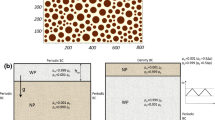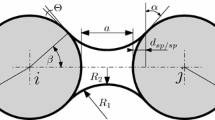Abstract
This paper presents a numerical study of capillary interfaces using the Single Component Multi-Phase Shan–Chen model, which is based on the lattice Boltzmann method. Despite the simplicity of the model, it has been shown to be effective and the present study aims to test its ability to correctly reproduce the physics of multiphase systems. To this end, several benchmark simulations were carried out in the configurations of a drop on a flat wall and then on a spherical surface to characterize the wetting behavior and relate explicitly the contact angle to model parameters. In addition, the capillary forces induced by a liquid bridge between two spherical particles were numerically calculated. We show that the results obtained are in agreement with experimental and theoretical results from the literature. The model is thus accurate in addressing the wetting behavior and capillary interfaces in unsaturated granular soils despite the fact that surface tension and contact angles are not explicit parameters of the model. To this respect, explicit relationships with Shan–Chen parameters are provided.
Graphic abstract


























Similar content being viewed by others
Notes
Note that \(F_{\alpha }\) can be linked to \({\varvec{F}}\) for instance following Guo et al. [12] through: \(F_{\alpha }=w_{\alpha } \left( \frac{{\varvec{c}}_{\alpha }-{\varvec{u}}}{c_s^2}+\frac{({\varvec{c}}_{\alpha } \cdot {\varvec{u}}){\varvec{c}}_{\alpha }}{c_s^4} \right) \cdot {\varvec{F}}\).
To recover Navier-Stokes equation with BGK collision operator.
Note that for an “ideal” or “perfect” gas laws, the pressure is \(P(\rho )=\rho c_s^2\).
The physical thermodynamic properties for water at the critical point are critical temperature \(T_c=373.946\, ^{\circ }\hbox {C} = 647.096 \,^{\circ }\hbox {K}\), critical pressure \(P_c=217.7 \,\hbox {atm} = 220.6 \,\hbox {bar} = 22.06 \,\hbox {MPa}\), and critical density \(\rho _c=322 \,\hbox {kg}/\hbox {m}^3\).
The volume of a spherical cap of height h and radius R is \(V_{cap}(R,h) = \frac{1}{3}\pi h^2(3R-h)\).
For small values of \(\theta \), the improved virtual-density scheme [17] appears less accurate for a drop on convex solid surfaces than on flat surfaces due to the discretization of the surface.
In [34] , the authors used a free-energy method to model two-phase liquid-vapor flows with an approach which is different from the Shan–Chen model used here.
The time scale for flows that are controlled by Reynolds number is classically given by: \(\Delta t_{phy} = c_s^2 (\tau -\frac{1}{2})\Delta x_{phy}^2/\nu _{phy}\), where \(c_s\) and \(\tau \) in lattice units [16].
References
Benzi, R., Biferale, L., Sbragaglia, M., Succi, S., Toschi, F.: Mesoscopic modeling of a two-phase flow in the presence of boundaries: the contact angle. Phys. Rev. E 74, 021509 (2006). https://doi.org/10.1103/PhysRevE.74.021509
Benzi, R., Succi, S., Vergassola, M.: The lattice Boltzmann equation: theory and applications. Phys. Rep. 222(3), 145–197 (1992). https://doi.org/10.1016/0370-1573(92)90090-M
Brakke, K.A.: The surface evolver. Exp. Math. 1(2), 141–165 (1992). https://doi.org/10.1080/10586458.1992.10504253
Cartwright, H.: Molecular thermodynamics. by Donald A. Mcquarrie and John D. Simon.(1999) University Science Books, 55d Gate Five Road, Sausalito CA 94965, USA. 672 pp \$78.00, ISBN 1-891389-05-X. Chem. Educ. 4(3), 120–121 (1999)
Chen, L., Kang, Q., Mu, Y., He, Y.L., Tao, W.Q.: A critical review of the pseudopotential multiphase lattice Boltzmann model: methods and applications. Int. J. Heat Mass Transf. 76, 210–236 (2014). https://doi.org/10.1016/j.ijheatmasstransfer.2014.04.032
Connington, K.W., Lee, T., Morris, J.F.: Interaction of fluid interfaces with immersed solid particles using the lattice Boltzmann method for liquid–gas–particle systems. J. Comput. Phys. 283, 453–477 (2015). https://doi.org/10.1016/j.jcp.2014.11.044
Delenne, J.Y., Richefeu, V., Radjai, F.: Liquid clustering and capillary pressure in granular media. J. Fluid Mech. 762, R5 (2015). https://doi.org/10.1017/jfm.2014.676
Duriez, J., Wan, R.: Contact angle mechanical influence in wet granular soils. Acta Geotech. 12(1), 67–83 (2017)
Fakhari, A., Mitchell, T., Leonardi, C., Bolster, D.: Improved locality of the phase-field lattice-Boltzmann model for immiscible fluids at high density ratios. Phys. Rev. E 96(5), 053301 (2017)
Fan, Z., Qiu, F., Kaufman, A., Yoakum-Stover, S.: GPU cluster for high performance computing. In: IEEE/ACM SC2004 Conference, Proceedings, pp. 297–308 (2004)
Gagneux, G., Millet, O.: Analytic calculation of capillary bridge properties deduced as an inverse problem from experimental data. Transp. Porous Media 105, 117–139 (2014)
Guo, Z., Zheng, C., Shi, B.: Discrete lattice effects on the forcing term in the lattice Boltzmann method. Phys. Rev. E 65, 046308 (2002). https://doi.org/10.1103/PhysRevE.65.046308
Huang, H., Krafczyk, M., Lu, X.: Forcing term in single-phase and Shan–Chen-type multiphase lattice Boltzmann models. Phys. Rev. E 84, 046710 (2011). https://doi.org/10.1103/PhysRevE.84.046710
Huang, H., Li, Z., Liu, S., Lu, X.Y.: Shan-and-Chen-type multiphase lattice Boltzmann study of viscous coupling effects for two-phase flow in porous media. Int. J. Numer. Methods Fluids 61(3), 341–354 (2009). https://doi.org/10.1002/fld.1972
Huang, H., Sukop, M., Lu, X.: Multiphase Lattice Boltzmann Methods: Theory and Application. Wiley, Hoboken (2015)
Krueger, T., Kusumaatmaja, H., Kuzmin, A., Shardt, O., Silva, G., Viggen, E.: The Lattice Boltzmann Method: Principles and Practice. Graduate Texts in Physics. Springer, Berlin (2016)
Li, Q., Yu, Y., Luo, K.H.: Implementation of contact angles in pseudopotential lattice Boltzmann simulations with curved boundaries. Phys. Rev. E 100, 053313 (2019). https://doi.org/10.1103/PhysRevE.100.053313
Liang, H., Xu, J., Chen, J., Wang, H., Chai, Z., Shi, B.: Phase-field-based lattice Boltzmann modeling of large-density-ratio two-phase flows. Phys. Rev. E 97(3), 033309 (2018)
Mielniczuk, B., Millet, O., Gagneux, G., El Youssoufi, M.S.: Characterisation of pendular capillary bridges derived from experimental data using inverse problem method. Granul. Matter 20(1), 14 (2018). https://doi.org/10.1007/s10035-017-0784-8
Miot, M., Wautier, A., Veylon, G., Philippe, P., Nicot, F.: Numerical modeling of capillary forces in mesoscale assemblies of grains: from pendular to funicular regimes. Accepted for publication in Granular Matter (2021)
Montellá, E.P., Yuan, C., Chareyre, B., Gens, A.: Hybrid multi-scale model for partially saturated media based on a pore network approach and lattice Boltzmann method. Adv. Water Resour. 144, 103709 (2020). https://doi.org/10.1016/j.advwatres.2020.103709
Nguyen, H.N.G., Millet, O., Gagneux, G.: Exact calculation of axisymmetric capillary bridge properties between two unequal-sized spherical particles. Math. Mech. Solids 24(9), 2767–2784 (2018). https://doi.org/10.1177/1081286518787842
Nguyen, H.N.G., Millet, O., Gagneux, G.: On the capillary bridge between spherical particles of unequal size: analytical and experimental approaches. Continuum Mech. Thermodyn. 31(1), 225–237 (2018). https://doi.org/10.1007/s00161-018-0658-2
Nguyen, H.N.G., Millet, O., Gagneux, G.: Liquid bridges between a sphere and a plane—classification of meniscus profiles for unknown capillary pressure. Math. Mech. Solids 24(10), 3042–3060 (2019). https://doi.org/10.1177/1081286519831047
Nguyen, H.N.G., Millet, O., Zhao, C.F., Gagneux, G.: Theoretical and experimental study of capillary bridges between two parallel planes. Eur. J. Environ. Civ. Eng. (2020). https://doi.org/10.1080/19648189.2019.1706055
Nguyen, H.N.G., Zhao, C.F., Millet, O., Gagneux, G.: An original method for measuring liquid surface tension from capillary bridges between two equal-sized spherical particles. Powder Technol. 363, 349–359 (2020). https://doi.org/10.1016/j.powtec.2019.12.049
Nguyen, H.N.G., Zhao, C.F., Millet, O., Selvadurai, A.: Effects of surface roughness on liquid bridge capillarity and droplet wetting. Powder Technol. 378, 487–496 (2021). https://doi.org/10.1016/j.powtec.2020.10.016
Pan, C., Hilpert, M., Miller, C.T.: Lattice-Boltzmann simulation of two-phase flow in porous media. Water Resour. Res. 40(1) (2004). https://doi.org/10.1029/2003WR002120
Pitois, O., Moucheront, P., Chateau, X.: Liquid bridge between two moving spheres: an experimental study of viscosity effects. J. Colloid Interface Sci. 231(1), 26–31 (2000). https://doi.org/10.1006/jcis.2000.7096
Richefeu, V., Radjai, F., Delenne, J.Y.: Lattice Boltzmann modelling of liquid distribution in unsaturated granular media. Comput. Geotech. 80, 353–359 (2016). https://doi.org/10.1016/j.compgeo.2016.02.017
Richefeu, V., Radjai, F., El Youssoufi, M.: Stress transmission in wet granular materials. Eur. Phys. J. E 21(4), 359–369 (2006). https://doi.org/10.1140/epje/i2006-10077-1
Shan, X., Chen, H.: Lattice Boltzmann model for simulating flows with multiple phases and components. Phys. Rev. E 47(3), 1815–1819 (1993). https://doi.org/10.1103/PhysRevE.47.1815. (Cited By 2297)
Shan, X., Chen, H.: Simulation of nonideal gases and liquid–gas phase transitions by the lattice Boltzmann equation. Phys. Rev. E 49(4), 2941–2948 (1994). https://doi.org/10.1103/PhysRevE.49.2941. (Cited By 954)
Shinto, H., Komiyama, D., Higashitani, K.: Lattice Boltzmann study of capillary forces between cylindrical particles. Adv. Powder Technol. 18(6), 643–662 (2007). https://doi.org/10.1163/156855207782514950
Singh, P., Joseph, D.D.: Fluid dynamics of floating particles. J. Fluid Mech. 530, 31–80 (2005). https://doi.org/10.1017/S0022112005003575
Sukop, M.C., Or, D.: Lattice Boltzmann method for modeling liquid-vapor interface configurations in porous media. Water Resour. Res. 40(1) (2004). https://doi.org/10.1029/2003WR002333
Sun, X., Sakai, M.: Direct numerical simulation of gas-solid-liquid flows with capillary effects: an application to liquid bridge forces between spherical particles. Phys. Rev. E 94, 063301 (2016). https://doi.org/10.1103/PhysRevE.94.063301
Swift, M.R., Osborn, W., Yeomans, J.: Lattice Boltzmann simulation of nonideal fluids. Phys. Rev. Lett. 75(5), 830 (1995)
Wu, D., Wang, P., Wu, P., Yang, Q., Liu, F., Han, Y., Xu, F., Wang, L.: Determination of contact angle of droplet on convex and concave spherical surfaces. Chem. Phys. 457, 63–69 (2015). https://doi.org/10.1016/j.chemphys.2015.05.020
Yang, L., Sega, M., Harting, J.: Capillary-bridge forces between solid particles: insights from lattice Boltzmann simulations (2020)
Yuan, P., Schaefer, L.: Equations of state in a lattice Boltzmann model. Phys. Fluids 18(4), 042101 (2006). https://doi.org/10.1063/1.2187070
Zheng, H., Shu, C., Chew, Y.T.: A lattice Boltzmann model for multiphase flows with large density ratio. J. Comput. Phys. 218(1), 353–371 (2006)
Zou, Q., He, X.: On pressure and velocity boundary conditions for the lattice Boltzmann BGK model. Phys. Fluids 9(6), 1591–1598 (1997). https://doi.org/10.1063/1.869307
Zu, Y., He, S.: Phase-field-based lattice Boltzmann model for incompressible binary fluid systems with density and viscosity contrasts. Phys. Rev. E 87(4), 043301 (2013)
Acknowledgements
The authors would like to express their sincere gratitude to the French National Centre for Space Studies (CNES) and to the NEEDS program for having supported this work. They also acknowledge the International Research Network GeoMech (IRN CNRS) for enabling intensive and productive interactions between all of them. In particular the authors would like to thank Marie Miot for insightful discussions on the different strategies to compute capillary forces in numerical simulations.
Author information
Authors and Affiliations
Corresponding author
Ethics declarations
Conflict of interest
The authors declare that they have no conflict of interest.
Additional information
Publisher's Note
Springer Nature remains neutral with regard to jurisdictional claims in published maps and institutional affiliations.
Appendix: Conversion between physical and lattice units
Appendix: Conversion between physical and lattice units
The LBM simulations with Shan–Chen model involve four dimensional quantities: time, length, mass and temperature. The conversion between lattice units and physical units is done with use of the reduced properties concept [4, 41] for the fluid properties (namely density \(\rho \), pressure P, and temperature T) and with one additional conversion factors for length.
where the subscript “R” and “c” are the reduced and critical properties, respectively. According to this concept, the reduced properties in lattice and physical units should be equal. As an example, we have \(\rho _R^{lu}=\rho _R^{phy}\), leading to \(\rho ^{phy}=\rho ^{lu}\rho ^{phy}_c/\rho ^{lu}_c\). The other properties can be obtained in a similar manner.
The conversion factors for length, time and density are respectively \(C_l=\Delta x_{phy}/\Delta x_{lu}\), \(C_t=\Delta t_{phy}/\Delta t_{lu}\), and \(C_{\rho }=\rho _{phy}/\rho _{lu}=\rho ^{phy}_c/\rho ^{phy}_c\). The conversion factor for force can the be deduced as \(C_f=C_{\rho } C_l^4/C_t^2\). To get the value in physical units, the corresponding value in lattice units is multiplied by the conversion factor that has the same physical units. For example, for length we have \(L_{phy}=L_{lu}\times C_l\).
For capillary interfaces with no flow, where the Reynolds number is no longer relevant, the time scale is not given by viscosity.Footnote 8 The conversion between surface tension \(\gamma \) in lattice and physical units reads
In the presence of gravity, the conversion between gravity in lattice and physical units is given as
Alternatively, physical units can be related to lattice units through dimensionless numbers (e.g. the Bond number (Bo)) instead of using the conversion factors. As an example, the dimensionless Bond number is defined as
where g is the gravity, \(\gamma \) is the surface tension and r is the length scale (e.g. drop radius in the case studied in Sect. 3.2). By setting \(Bo_{lattice}=Bo_{physical}\), the conversion leads to
Expression (41) enables to fix the gravity in lattice units \(g^{lu}\) that can be used in LBM simulation when taking it into account.
Rights and permissions
About this article
Cite this article
Benseghier, Z., Millet, O., Philippe, P. et al. Relevance of capillary interfaces simulation with the Shan–Chen multiphase LB model. Granular Matter 24, 82 (2022). https://doi.org/10.1007/s10035-022-01243-5
Received:
Accepted:
Published:
DOI: https://doi.org/10.1007/s10035-022-01243-5




